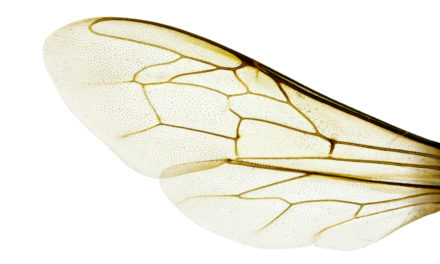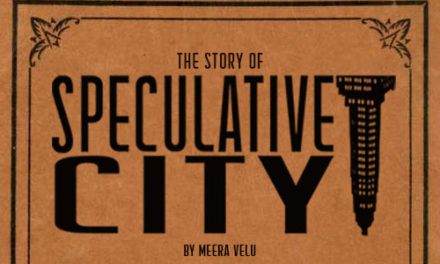Dorothy, Representing a New Sound in Publishing
Issue 12: Sound | 2,386 words

After flipping through another book on my shelf and recognizing the feel and the shape, I realized that I’d come to own several works published by the Dorothy project. Run by Danielle Dutton and Martin Riker, Dorothy is a small operation that cultivates and showcases works that cross literary boundaries.
As a fellow publisher, I have a deep appreciation for how Dorothy brings forth works that, as Martin describes, represent “a new sound in language.”
The project inspires, and I interview Danielle and Martin to get a better understanding of how the two have built the success that is Dorothy.
If you read further, you’ll also find it’s no coincidence the Dorothy books stand out on the shelf.
Meera: Dorothy has been described as a project that publishes experimental works. Speculative City features speculative fiction, as its name none too subtly suggests. What has always drawn me to that form of fiction is its tendency to experiment, both in prose form and narrative. How would you define Dorothy’s experimental works?
Martin Riker: We like the word “experimental” but also try to avoid using it, because it’s too easy for people to think of “experimental” as a category rather than an impulse. It’s ironic, since the impulse to experiment is also an impulse to transgress (or at least to not really bother about) categories. We’re interested in work that seems new to us, and also great. A voice or way of using language that we haven’t experienced before, and that, beyond being new, is compelling. We derive a lot of our pleasure as readers from the language itself, from form, the surprising ways a writer puts language and narrative together; and probably for anyone who reads that way, the impulse to experiment is something like a prerequisite. But the results are, by definition, always different from one another. Our books are very different from one another. When they start to feel similar—for example if we have a couple of years of French work, or a couple of seasons in which we have surrealist or fantastical work—then we tend to turn in a different direction for a while.
Meera: Speculative fiction falls into the category of genre fiction. You’re both trained in literature and work in literary institutions, and many would say that represents the other side of the fiction world—literary fiction. What’s your opinion on such labels, and what would you say are their advantages and disadvantages when it comes to publishing?
Riker: The way I think about this is embarrassingly similar to how I responded to your first question. I think “genre” and “literary” are better understood as impulses rather than categories. As impulses, “genre” is the impulse toward familiarity and formula, while “literary” is the impulse toward surprise and invention.
The reason that’s not as hoity toity as it sounds is because I’m not talking about categories. What I’m saying is that every writer works within a spectrum of these two impulses, and every work is the result of a back-and-forth between creating something that is familiar and fulfills the reader’s expectations versus something that surprises the reader’s expectations. Every work is both genre and literary.
Unfortunately, this way of thinking renders the categories pretty useless, so then I might backpedal and say that when we refer to a work as a “genre” work, we mean that the impulse toward familiarity (or formula) is emphasized over the impulse toward surprise. Romance novels are sort of famous for fulfilling expectations, for example. And when we refer to a work as “literary,” it’s surprise and inventiveness that’s emphasized. So science fiction may be a genre, but particular works of science fiction—Ubik, say, or Dhalgren—might be very far from being “genre” works. I’m sure there are all sorts of limits to this way of thinking, but it has the advantage of allowing us to talk about each book for what it is, rather than seeing some books as exceptions to arbitrary rules or norms.
Of course that’s not how books are sold and how the industry talks about them in order to sell them. But we don’t have to worry about these categories too much with Dorothy, because our books are pretty squarely “literary.” The bigger issue for us is that our books are so “literary” they often don’t fall into any of the subcategories that the industry provides for what a “literary” book is; for example Nathalie Leger’s books, which are sort of novels, sort of memoirs, kind of literary criticism, a little bit art theory. It’s a total mash, yet you have to assign it into categories for the industry to know how to sell it, or even for something as practical as whether it goes to the nonfiction or the fiction editor at a particular review publication.
Meera: Dorothy publishes debuts, translations, and rediscoveries. What is Dorothy’s process of finding works?
Riker: A few of our books have come as suggestions from friends, or through soliciting writers we already knew. Some have come as submissions from people (or agents, who it turns out are also people) we didn’t know at all. A couple of times we’ve seen something in a magazine (BOMB and Asymptote, specifically) and then hunted down the writer or translator to find out more.
Maybe the most interesting, in terms of your question, is the number of books we have made ourselves. The Leonora Carrington story collection, the Marguerite Duras essay collection, and now the forthcoming Cristina Rivera Garza story collection are all books we either thought up ourselves or played a part in conceiving. They’re books that wouldn’t exist, at least not in the form they are in, if we hadn’t helped imagine them. That’s a lot of fun for us. But at the end of the day, it doesn’t really matter to us how projects come about, in terms of how excited we are about each book.
Meera: The theme of the next Speculative City issue is sound. Dorothy published Cristina Rivera Garza’s The Taiga Syndrome, and the work ends with a playlist (which a devout reader compiled on YouTube!). The playlist could act as a soundtrack to the story or as a next chapter that subverts the written form, potentially an antagonism toward the story’s protagonist who has an “all-consuming weakness for forms of writing no longer in use.” It’s quite an inventive way to fold visceral sound into a written story. Do you know of other works of fiction that play with sound in such a way—perhaps other pieces in the Dorothy catalog?
Riker: I love this question. And Cristina’s work is so largely about sound. I mean, not even counting the playlist, she is maybe the most phonic writer we’ve published, in the degree to which sound is a determining element in the overall experience of her prose. But I do think you’re onto something. One of the ways Dorothy authors might be thought about as having something in common is that each represents a new sound in language, a sound all their own. I talked about this in an interview I conducted with Amina Cain not too long ago—the idea that what made her work distinct for me wasn’t so much her “voice” or her “tone” but her “sound,” which was something larger, having to do with her whole relationship to language and narrative. In some ways, that could be said about any writer, but isolating it as a priority does, I think, start to get at something about the sorts of writers Dorothy publishes.
Meera: Sound, abstractly, is an “impression conveyed.” Several Dorothy books are posthumous publications. I see editing as collaborative, and so I’ve always wondered what the process looks like when the author is absent. In your experience editing deceased authors’ works, how have you retained the author’s original sound?
Danielle Dutton: I also think of editing as deeply collaborative, and we’re pretty hands-on most of the time, but much less so with the posthumous work we’ve published. For example, we did nothing at all to Barbara Comyns’s Who Was Changed and Who Was Dead. We did do a bit of editorial work with the Carrington collection, as some of the stories were previously unpublished, and what we were given were these typewritten pages covered in Carrington’s own largely unreadable handwriting. So we had to work with her there. But basically, when you edit a posthumous work you’re still trying to make the work sound particularly like itself, just as you would do with any living writer. And if you’re good at it, a careful reader, very sensitive to that writer’s sound, it really is a thing you can manage, I think, even without the writer beside you on this mortal coil or whatever. In fact, it still feels quite intimate to me, that work, and collaborative.
Meera: There’s a texture to written works, whether they’re in paper or online. As I had mentioned before, I finally realized I owned several Dorothy books after recognizing the feel and shape. How did you arrive at your trademark design?
Dutton: I knew when we started Dorothy that I wanted the books—as objects—to be attractive. We couldn’t afford to do anything wildly fancy in terms of the design or printing, but it was my plan to do everything I could to make the books physically pleasing, and part of that had to do with the uniform trim size (a somewhat unusual 5.5 x 7, which we stole, actually, from an old copy of Ubu Roi) and the uniform finish (a velvet matte laminate that makes you want to pet it).
Another part of it is that we are scrupulous about copyediting and interior design, something that doesn’t get as much attention as cover design. When I was working at Dalkey Archive Press, prior to starting Dorothy, I learned on the job from a brilliant book designer named Jeff Clark. I’m sure I only learned some tiny fraction of what he had to teach and what I should really know, but I think it’s been enough to ensure that our books feel clean and well conceived, inside and out. Oh, I guess I should have mentioned that I do all of our design and composition.
Meera: From what I’ve read in other interviews, Dorothy emerged as a reaction to a publishing industry that largely foregoes experimentation and female voices. And in the years since its founding, the project has gained quite a following. I’ve found that sometimes, when a project gains a strong audience, its vision can get logjammed because the creators feel beholden to competing expectations. I don’t know if that’s a fear, but how do you see Dorothy evolving?
Dutton: It’s an important question, and it is something we talk about. My sense is that what we are trying to do, actually, is not change too much, at least in the essentials. Like, we don’t want to be bullied (even by ourselves) into getting bigger, for example, or more commercially viable. It can be tempting, when you have a book or two do very well, to suddenly want that kind of “return” for every book. Of course, we want every book we publish to get attention, to be bought and read and taught and discussed, but that’s not how or why we choose what we choose. We don’t choose books we think will definitely get attention, just books we really want to spend time with, books we think we can do something for, books we want to see out in the world; and then we try as hard as we can to get attention for them. It’s also about finding books (and writers) that we want to insist matter, that we think should matter to the culture, to literature itself, and saying, Here, behold, voila, take note, world. I mean, that’s pretty much how it started, and so that’s what we try to stay focused on from year to year. But sometimes, yeah, we have to check in with ourselves about it. We have to make sure we’re choosing what we want to choose and not what we think we should choose, if that makes sense. We also, especially since we do all of it ourselves, have to make sure we aren’t getting bored.
Meera: Your project fills a gap in fiction publishing and is much appreciated. Outside of Dorothy, what would you like to see change within the industry?
Dutton: Thank you for saying that. There are all sorts of important ways publishing is working and starting to change right now, both in commercial and indie or nonprofit publishing—to be more inclusive, to showcase more diverse voices, to be staffed by a more diverse set of editors, etc.—and that’s as it should be. That has to happen.
Something I’d like to see more of, as well, is more aesthetic diversity, a more adventuresome readerly appetite on the part of editors, I guess. And critics, too. A lot of the work I see coming out of the big publishing houses (and magazines), and getting a chunk of the critical attention, all sounds more or less the same to me. It gets dull. I’d love to see “weirder” or more “experimental” writers getting more mainstream attention, writers like our own Renee Gladman, for example, or Bhanu Kapil, or Steven Dunn. Actually, all three of those writers recently won major awards, so maybe it’s starting? That would be cool. I’d love to see it.
Meera: What future Dorothy publications do you have for us to look forward to?
Dutton: So much to talk about. Our next two books will be the career-spanning New and Selected Stories by the brilliant Cristina Rivera Garza, translated mostly by Sarah Booker, and a completely bonkers novel about art and families and chronic pain and survival—Revenge of the Scapegoat, by Caren Beilin. And then the next two after that (we’re so ahead of schedule I can’t stand it) will be a lovely book-length essay on writing and art by Amina Cain and a debut fiction work from a fantastic young writer named Giada Scodellaro. Amina’s book is personally quite special to me because I’ve been quietly wanting her to write something like this ever since she published this wonderful essay online at The Paris Review in 2013.




